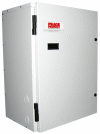|
 Digital phase
converters are a recent
development in phase converter technology that utilizes proprietary
software in a powerful microprocessor to control solid state power
switching components. This microprocessor, called a digital signal
processor (DSP), monitors the phase conversion process, continually
adjusting the input and output modules of the converter to maintain
perfectly balanced three-phase power under all load conditions. Digital phase
converters are a recent
development in phase converter technology that utilizes proprietary
software in a powerful microprocessor to control solid state power
switching components. This microprocessor, called a digital signal
processor (DSP), monitors the phase conversion process, continually
adjusting the input and output modules of the converter to maintain
perfectly balanced three-phase power under all load conditions.
Like rotary and static phase
converters, a digital phase converter generates a third voltage,
which is added to L1 and L2 of single-phase service to create
three-phase power. There the similarity ends.
A process called double-IGBT
conversion generates the third voltage. Double conversion means
that AC power from the utility is converted to DC, then back to AC.
The power switching devices
used in this process are insulated gate bipolar transistors (IGBT).
The input module, or rectifier,
consists of IGBTs in series with inductors. Operating at a
|
switching frequency of 10,000 Hz, the IGBTs are controlled by
software in the DSP to draw current from the single-phase line in a
sinusoidal fashion, charging capacitors on a constant voltage DC
bus. Because the incoming current is sinusoidal, there are no
significant harmonics generated back onto the line as there are with
the crude rectifiers found in most VFDs. The electronic power factor
correction on the input module also corrects the power factor of any
inductive loads so that the utility sees a system that operates at
near unity power factor. The power factor correction makes digital
phase converters very efficient and utility friendly
The output module, or inverter,
consists of IGBTs that draw on the power of the DC bus to create an
AC voltage. A voltage created by power switching devices like IGBTs
is not sinusoidal. It is a pulse-width-modulated (PWM) waveform
very high in harmonic distortion. This PWM voltage is then passed
through an inductor/capacitor filter system that produces a sine
wave voltage with less than 3% total harmonic distortion
(standards for computer grade power allow up to 5% THD). By contrast, VFDs
generate a PWM voltage that limits their versatility and makes them
unsuitable for many
|
applications. Software in the DSP continually
monitors and adjusts this generated voltage to produce a balanced
three-phase output at all times. It also provides protective
functions by shutting down in case of utility over-voltage and
under-voltage or a fault. With the ability to adjust to changing
conditions and maintain perfect voltage balance, a digital phase
converter can safely and efficiently operate virtually any type of
three-phase equipment or any number of multiple loads.
The solid state design results in a
relatively small package with no moving parts except for small
cooling fans. The converters are very efficient, operating at
95-98% efficiency. When the converter is energized with no load, it
consumes very little power.
Digital phase converters
are a patented technology developed by Phase Technologies, LLC, who
is the only manufacturer of true digital phase converters. |
|